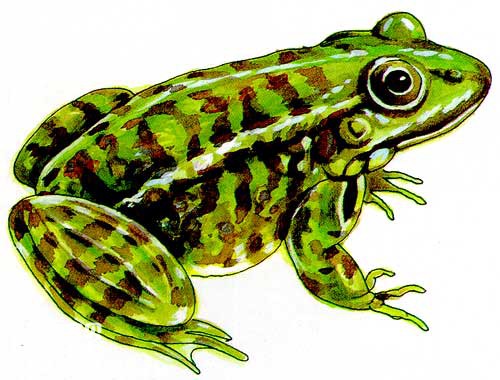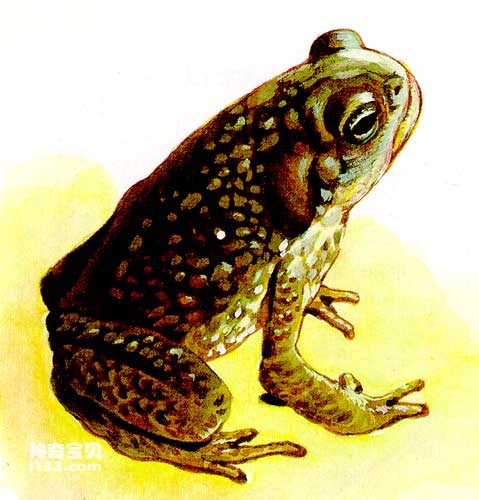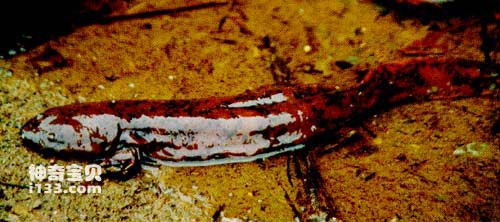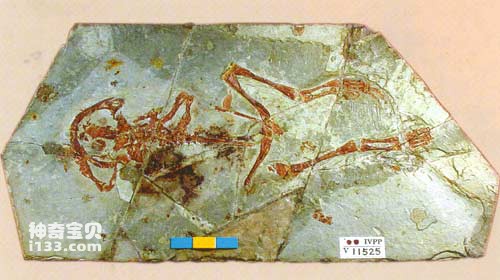Frogs, toads and salamanders are familiar amphibians. They are still active in ponds, rice fields, swamps, streams, rivers and wet places on land. All these living amphibians belong to a large family, the "slip-bodied amphibians", which used to be called "armorless amphibians". As the name suggests, these are animals with smooth bodies and no armor. There are approximately 4,000 species of these living amphibians, living in warm and humid environments on all land except Antarctica. Scientists divide them into three major categories: tailless amphibians, tailed amphibians and legless amphibians.

Legless amphibians are a very specialized group of amphibians. They look like earthworms, with no limbs and short tails, or no tail at all.
Most inapoda live in tropical areas and live in caves under camps. Ichthyosaurus is one of the representatives of this type of animal. Their skin is exposed, has many annular wrinkles, and is rich in mucus glands; their eyes are degenerated, but their sense of smell is well developed. This type of animal has a large number of vertebrae, some species have as many as 250 vertebrae, and the length of the largest anpod can reach 1.5 meters.
In addition to the above specialized characteristics, legless amphibians also show some primitive characteristics. For example, most amnipods have vestigial bony scales, but these scales do not cover the surface of the body like fish, but are trapped within the annular wrinkles of the skin. These degenerated small scales are regarded by some scholars as relics of ancient labyrinth scales, reflecting the primitive characteristics inherited by this type of animal.
There are more than 160 species of legless amphibians living in the tropics of Latin America, southern Asia and Africa. Xishuangbanna Ichthyosaurus is the only legless amphibian in my country. Fossils of amnipods are very rare. The oldest fossil amnipods were found in the early Jurassic strata in Arizona, USA, about 200 million years ago. They were named "Eocaecilians". What's special about it is that The animal has weak limbs, which also reflects its primitive nature. With the evolution of amnipods, these limbs have gradually shrunk, and have completely disappeared in the living species, making them true "apoda".

toad
Salamanders are "amphibians with tails." There are more than 350 living species, mainly distributed in the northern hemisphere. Only one type of tailed amphibians called "pneumonic salamanders" has entered South America in the southern hemisphere.
Many people confuse salamanders and lizards, but they are actually easy to distinguish. Salamanders are amphibians, but lizards (such as geckos) are reptiles; lizards' bodies are covered with scales, while axolotls' bodies are bare; in addition, salamanders generally have four "fingers" on their front legs, while lizards have five. .
The history of tailed amphibians can be traced back to the middle Jurassic period (about 170 million years ago). The earliest known representatives have been found in Central Asia and Western Europe, but these fossils are very scattered and fragmented. Recently, many beautifully preserved anuran fossils have been discovered in the early Cretaceous strata in Northeast my country. The ones that have been named include Zhongjian's Liaoxi Newt, Dongfangtang Newt, Strange Jehol Newt, Fengshan Chinese Newt, etc. They lived About 130 million to 110 million years ago. These fossils have the characteristics of early age, good preservation, large quantity, and rich species. Moreover, they are the earliest known representatives of modern salamanders in the world, and many of their characteristics can be compared with living species. It is speculated that the existing salamanders in the world may have evolved from this.
There are three families of tailed amphibians living in my country: Salamanderidae, Cryptobranchidae and Salamanderidae. The Mesozoic anuran fossils that have been reported in my country are all relatively primitive species. Their osteological characteristics are quite special and they cannot be classified into known families. However, preliminary research shows that Zhongjian's Liaoxi Newt and Dongfang Tang Newt are quite similar in morphology to small salamanders. The skull characteristics of Jehol Newt have certain similarities with some genera and species of Cryptobranchidae (such as Giant Salamander), but the individual of Jehol Newt is much smaller.

giant salamander
Tailless amphibians are customarily collectively referred to as "frogs". They also include frogs in a narrow sense (what we usually call frogs, etc.) and toads. The main difference between the two is: frogs have a smooth body surface, are light in body, like moist environments, are good at jumping, and have solid chest-shaped shoulder straps; while toads have rough and uneven body surfaces, bulky bodies, poor jumping ability, but strong drought resistance , with curved chest-shaped shoulder straps. However, the difference between the two is not very strict in biological taxonomy. Those called toads can also have strong jumping abilities, and those called frogs have also been found with arc-chested shoulder straps (such as wrinkled frogs).
The more primitive species of living tailless amphibians are all toads, such as the tailed toad in North America, the slippery toad in New Zealand, and the disc-tongued toad in Europe and North Africa. At the same time, fossil evidence shows that the arc-thorax shoulder straps Appeared earlier than the emergence of chest straps. From this perspective, the toad is the predecessor of the frog. In other words, the elegant frog evolved from a strange-looking toad.
In 1999, an ancient frog fossil unearthed from the early Cretaceous strata in western Liaoning attracted widespread attention from scientists at home and abroad. Wang Yuan, a young scholar at the Institute of Vertebrate Paleontology and Paleoanthropology, Chinese Academy of Sciences, named it "Sanyan Lichan". It is the earliest known frog in my country. It lived about 125 million years ago and lived in the same era as dinosaurs of all sizes.

Sanyan Lichan
Not only is the species early, but its fossils are also beautifully preserved, which is extremely rare among frog fossils. Because most frogs live in warm and humid environments, and their bones are thin and weak, they are difficult to preserve as fossils. In the past, only two or three relatively complete Cenozoic specimens were discovered in my country, including the Xuanwu frog from Linqu, Shandong (about 16 million years ago) and the Yushe frog from Wuxiang, Shanxi (about 5 million years ago). Frog fossils.
The skeletal morphology of Sanyan Litoad is very similar to that of living tailless amphibians, with developed ilium bones and elongated hind limbs, which indicates that it already has considerable jumping ability. The edge of its upper jaw is covered with thin, comb-like teeth. However, most of the frogs we see today do not have teeth, so having teeth is a primitive manifestation. Judging from this feature, the predatory function of the tongue and the movement ability of the body may not be strong enough, and the teeth play an important role in assisting in prey capture.
In taxonomy, the Sanyanli toad belongs to a species of Discoglossus toads. The European disc-tongued toad, the midwife toad and the Asian oriental toad are its closest living relatives. Judging from the appearance of these toads, the image of Sanyan Lichan is not good-looking either. Obviously, the name "Lily Chan" comes from its exquisite skeleton fossil, rather than the "appearance" of this type of animal.
In animal taxonomy, legless amphibians, tailless amphibians and tailed amphibians constitute three orders in the subclass Splenomegaly. In addition, there is a fourth order in the subclass Splenomegaly, the original order Anura, among which The representative is the tripartite frog found on the African island of Madagascar.
The Triassic Frog is the earliest known sliding-bodied amphibian and is already 240 million years old. This small animal is only about 10 centimeters long. It is surprising that it has the characteristics of a typical frog, but it appeared so early (early Triassic period). The skull of the Triassic Frog is simplified, the tail is shortened, the ilium in the girdle is extended forward, and the tibia and fibula are healed into one piece and elongated. These all indicate that it is developing in the direction of adapting to jumping life unique to frogs. At the same time, it has many primitive features: for example, the forelimbs retain 5 toes (instead of the 4 common toes in living amphibians), the trunk has a larger number of vertebrae, and the tail is still composed of several vertebrae, rather than the 4 toes common in living frogs. The unique healing is the coccyx bone.
Can the Triassic Frog represent the ancestral type of gliding amphibians? Most scientists hold a negative attitude towards this. Because frogs are considered a specialized group among amphibians. Not only because of their unique jumping lifestyle, but also because their skeletal structure is quite simplified compared with the ancient labyrinths and conchovertebrate amphibians. From this point of view, the appearance and skeletal characteristics of tailed amphibians are closer to the ancestral type of gliding amphibians. However, the earliest tailed amphibian fossils appeared much later than frogs. The reason for this difference is not yet clear, but it is believed that this issue will eventually be resolved as more fossils are discovered.
Also troubling scientists is another question that must be answered - from which ancient amphibian or animals did slippery amphibians evolve? The currently dominant view is that the common ancestral type of all sliding-bodied amphibians evolved from a certain type of dissociated vertebrate in the labyrinth amphibians, and that all modern amphibians have a common ancestor. This view is called the "single origin theory". In contrast, there is the "multiple origin theory", which believes that tailless amphibians evolved from spondyloids, while tailed amphibians and legless amphibians may have evolved from shellvertebrates. At present, it is difficult to determine which of the two hypotheses is which, and this is also an unsolved mystery in the evolution of modern amphibians.
animal tags: frog toad salamander
We created this article in conjunction with AI technology, then made sure it was fact-checked and edited by a Animals Top editor.